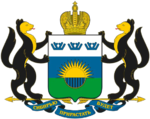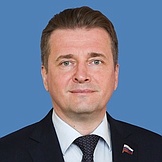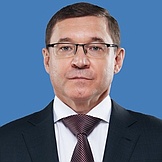Regional flags and emblems


PROFILE
The Tyumen Region includes two full-fledged members of the Russian Federation: the Khanty-Mansi Autonomous Area – Yugra and the Yamal-Nenets Autonomous Area.
Established 14 August 1944
Capital Tyumen
The Tyumen Region is part of the Urals Federal District
Area (excluding autonomous areas) 1 600 100 sq km
Population (excluding autonomous areas) 1 625 100 (2025)
Ethnic groups
(2020 National Census, %)
Russian – 85,85
Tatar – 6,93
Kazakh – 1,03
Other – 6,19
Administrative Divisions (without Autonomous Areas) (2024)
Municipal districts – 20
City districts – 6
Rural districts – 273
Geography and climate
The Tyumen Region, including the Khanty-Mansi Autonomous Area – Yugra and the Yamal-Nenets Autonomous Area, stretches from the steppes of Kazakhstan towards the Arctic Ocean coast and occupies a substantial part of the West Siberian Plain. The region is Russia’s third largest after Yakutia and the Krasnoyarsk Territory.
The Tyumen region stretches 2,100 km from north to south and 1,400 km from east to west.
It borders on the Komi Republic, the Krasnoyarsk Territory, the Kurgan, Sverdlovsk, Tomsk and Omsk regions, as well as on the Nenets Autonomous Area and shares a state border with the Republic of Kazakhstan.
The region has a harsh climate, with 90% of its territory part of the Far North or similar conditions as the Far North.
January temperatures average from –17°C around Tyumen to –27°C in the northern areas, with the coldest period lasting from 130 days a year in Tyumen to 210 days and more in the tundra.
The region has numerous rivers and lakes. The Irtysh, Tobol, Ishim, Tavda and Tura are the longest rivers, and the largest lakes are Boshoi Uvat and Chernoye.
The region (without the autonomous areas) has 97 specially protected nature reserves, including two federal reserves: the Belozersky and Tyumensky wildlife sanctuaries.
Government
The legislative branch is represented by the Tyumen Regional Duma, which is the permanent, representative and only body of legislative authority in the region.
The Tyumen Regional Duma has 48 deputies elected for five years, with 24 of them running in single-mandate constituencies and the other 24 elected from among the list of candidates of electoral associations.
The current Tyumen Regional Duma was elected in September 2021. Its term expires in September 2026.
The executive branch is the Government of the Tyumen Region headed by the Governor and other bodies of executive authority. The Government of the Tyumen Region is the supreme, permanent body of executive authority in the region.
The Governor of the Tyumen Region is the region’s highest-ranking official, who heads the Government of the Tyumen Region. The Governor is elected for five years by Russian citizens who permanently reside in the region. The term of office of the incumbent Governor expires in September 2028.
Economy and natural resources
Tyumen region has significant natural resources.
The region produces peat, sapropel, quartz sands, brick-grade and expanded clay, limestone, construction stone and other minerals. Work is underway to actively develop the Uvatskaya group of deposits of oil in the north of the region.
The south of the region is rich in reserves of freshwater as well as substantial mineral water reserves. Subterranean waters account for over 50% of Russia’s iodine and bromine reserves. The largest iodine-bromine deposits are Cherkashinskoye and Tobolsk.
The region has large forests and a diverse fauna.
About 30 fish species, including 20 commercial fish varieties, inhabit local water bodies.
The region’s diverse natural resources and its proximity to the economically developed regions in European Russia, primarily the Urals, guarantee its sustained economic development and make it an attractive region for investment.
Industrial output accounts for over 36% of the regional GDP.
The region’s industry is dominated by the manufacturing and the machine building for the oil and gas sector, manufacture of construction materials, the fuel industry, pharmaceuticals, the wood processing industry and the power industry.
New high-tech sectors, including oil refining and petro-chemistry, the manufacture of polymers, ferrous metals, glass and bioengineering, continue to emerge.
The development of the region's industry is highly influenced by the oil and gas territories of the Khanty-Mansi Autonomous Area – Yugra and the Yamal-Nenets Autonomous Area, which are distinguished by a high need for imported resources for production activities and life support of the population. The region supplies the autonomous areas with equipment and technical means for the oil and gas industry, construction materials, food and other goods.
Major regional companies include the Limited liability company ”Zapadno-Sibirsky Neftekhimichesky combine“, the Tyumen Machinery Plant CJSC, the Yalutorovsk Foundry, the Zavodoukovsk Machine Building Plant, the Tyumen Storage Battery Plant, the Antipinsky Oil Refinery, the Ishim Machine Building Plant, the Tyumen Motor Plant, the Tyumen Medical Equipment Plant, the Krasny Oktyabr Wood Processing Plant.
Power industry companies meet the region’s electricity demand in full and transmit power to other regions. Thermal power stations No. 1 and No. 2 in Tyumen are among the largest European power generating companies using casinghead gas.
Modernization of the airport in Tobolsk, construction of a complex for the production, storage and shipment of liquefied natural gas, which will become a part of the West Siberian petrochemical cluster are the most important projects in the region.
Agriculture and related industries are developing rapidly. The main branches of agriculture are grain production, meat and dairy cattle raising, pig farming, poultry farming, potato farming. The region is completely self-sufficient in agricultural staples and delivers them to dozens of Russian regions.
Culture and tourism
Tyumen and the Tyumen Region are traditionally known as Gateway to Siberia. Famous Russian explorers started developing Siberian territories from here. The region’s historical communities, including Nizhnyaya Tavda, Isker and Vagay remember the legendary campaign of Cossack ataman (chief) Yermak Timofeyevich and his private army, which ended in the defeat of the Siberian Khanate in 1582.
Tobolsk stands out among other ancient Siberian cities, as a pearl amidst ancient Siberian towns. It is famous for its old churches, immensely rich history, and it widely known as the spiritual capital of Siberia.
The biggest treasure and pride of Tobolsk is its white stone Kremlin. Today it houses the Tobolsk History and Architecture Museum Reserve, which includes 33 landmarks of federal importance.
Trade routes linking European Russia with China and Central Asia, including the Great Silk Road and the Tea Road, passed via Tobolsk.
The lives of many prominent Russians are linked with the history of Tobolsk, including architect and chronicler Semyon Remezov, chemist Dmitry Mendeleyev, composer Alexander Alyabyev, fairy tale writer Pyotr Yershov, artist Vasily Perov and many others. Nicholas II, the last Russian Emperor, and his family, were exiled to Tobolsk in 1917.
Russia’s only bone carving factory is located in Tobolsk.
The region’s religious shrines attract pilgrims from all over Russia. Four monasteries and convents, including the Trinity Tyumen Male Monastery, the Convent of the Nativity of the Mother of God Female Monastery, the Abalak Male Monastery of the Holy Sign and the St John Convent of the Presentation in the Temple Female Monastery, are located in the Tyumen Region. All monasteries and convents have the status of historical and architectural landmarks and have witnessed numerous historical and cultural events.
The Tyumen Region has thriving theatre, music, art, museums and libraries, traditional folk culture, and can offer a wide variety of cultural leisure activities.
Each year, the region hosts numerous traditional folk celebrations and open-air events, festivals and fairs, including the Mamontov festival of creative folk art, the Alyabyev Musical Autumn art festival, the Abalak Field historical re-enactment festival and others. The Decembrist Soirees historical cultural festival, held since 1988, ranks among the most outstanding and large-scale regional events.
The region’s rich historical and cultural heritage makes it an attractive tourist destination. The Tyumen Region has over 1,000 historical and cultural sites, as well as hundreds of archaeological landmarks.
The Tyumen Region provides ample leisure and recreation opportunities, and boasts numerous health-resorts.
Active leisure buffs take advantage of the numerous local sports facilities and take part in many sport events attracting people from around Russia and beyond.
The Tyumen Region is also famous for its hunting and fishing opportunities, mostly in the Uvat, Tobolsk, Vagay, Yarkovo, Vikulovo, Armizonskoye, Nizhnyaya Tavda and Kazanskoye districts. Highly developed are hunting and fishing grounds in distinct exclusion zones with quality service and infrastructure for tourists.
The region offers a wealth of unique natural curative factors, such as mineral water springs, thermal springs and curative sapropel muds. Today, the region operates over 25 spas, preventive treatment facilities, tourist camps and holiday hotels that use the region’s natural curative factors for preventing and treating various health disorders. The most popular of them include Taraskul, Sibir, Lastochka, Akhmanka, Ishimsky and others.


